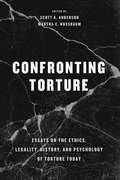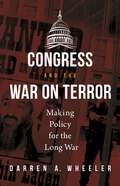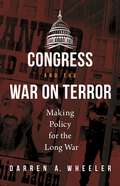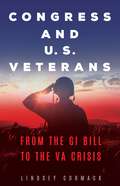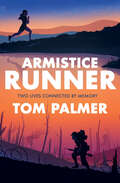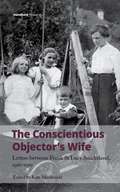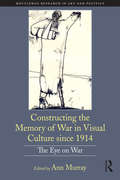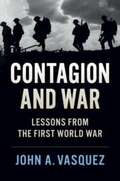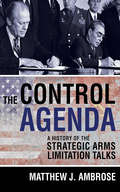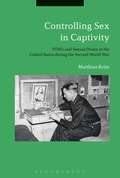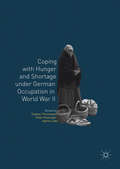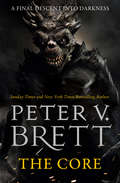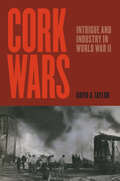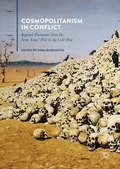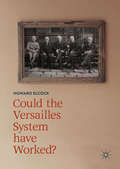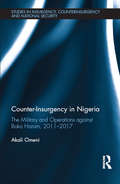- Table View
- List View
Confronting Torture: Essays on the Ethics, Legality, History, and Psychology of Torture Today
by Scott Anderson Martha C. NussbaumTorture has lately become front page news, featured in popular movies and TV shows, and a topic of intense public debate. It grips our imagination, in part because torturing someone seems to be an unthinkable breach of humanity—theirs and ours. And yet, when confronted with horrendous events in war, or the prospect of catastrophic damage to one’s own country, many come to wonder whether we can really afford to abstain entirely from torture. Before trying to tackle this dilemma, though, we need to see torture as a multifaceted problem with a long history and numerous ethical and legal aspects. Confronting Torture offers a multidisciplinary investigation of this wrenching topic. Editors Scott A. Anderson and Martha C. Nussbaum bring together a diversity of scholars to grapple with many of torture’s complexities, including: How should we understand the impetus to use torture? Why does torture stand out as a particularly heinous means of war-fighting? Are there any sound justifications for the use of torture? How does torture affect the societies that employ it? And how can we develop ethical or political bulwarks to prevent its use? The essays here resist the temptation to oversimplify torture, drawing together work from scholars in psychology, history, sociology, law, and philosophy, deepening and broadening our grasp of the subject. Now, more than ever, torture is something we must think about; this important book offers a diversity of timely, constructive responses on this resurgent and controversial subject.
Confronting Torture: Essays on the Ethics, Legality, History, and Psychology of Torture Today
by Scott A. Anderson Martha C. NussbaumTorture has lately become front page news, featured in popular movies and TV shows, and a topic of intense public debate. It grips our imagination, in part because torturing someone seems to be an unthinkable breach of humanity—theirs and ours. And yet, when confronted with horrendous events in war, or the prospect of catastrophic damage to one’s own country, many come to wonder whether we can really afford to abstain entirely from torture. Before trying to tackle this dilemma, though, we need to see torture as a multifaceted problem with a long history and numerous ethical and legal aspects. Confronting Torture offers a multidisciplinary investigation of this wrenching topic. Editors Scott A. Anderson and Martha C. Nussbaum bring together a diversity of scholars to grapple with many of torture’s complexities, including: How should we understand the impetus to use torture? Why does torture stand out as a particularly heinous means of war-fighting? Are there any sound justifications for the use of torture? How does torture affect the societies that employ it? And how can we develop ethical or political bulwarks to prevent its use? The essays here resist the temptation to oversimplify torture, drawing together work from scholars in psychology, history, sociology, law, and philosophy, deepening and broadening our grasp of the subject. Now, more than ever, torture is something we must think about; this important book offers a diversity of timely, constructive responses on this resurgent and controversial subject.
Confronting Torture: Essays on the Ethics, Legality, History, and Psychology of Torture Today
by Scott A. Anderson Martha C. NussbaumTorture has lately become front page news, featured in popular movies and TV shows, and a topic of intense public debate. It grips our imagination, in part because torturing someone seems to be an unthinkable breach of humanity—theirs and ours. And yet, when confronted with horrendous events in war, or the prospect of catastrophic damage to one’s own country, many come to wonder whether we can really afford to abstain entirely from torture. Before trying to tackle this dilemma, though, we need to see torture as a multifaceted problem with a long history and numerous ethical and legal aspects. Confronting Torture offers a multidisciplinary investigation of this wrenching topic. Editors Scott A. Anderson and Martha C. Nussbaum bring together a diversity of scholars to grapple with many of torture’s complexities, including: How should we understand the impetus to use torture? Why does torture stand out as a particularly heinous means of war-fighting? Are there any sound justifications for the use of torture? How does torture affect the societies that employ it? And how can we develop ethical or political bulwarks to prevent its use? The essays here resist the temptation to oversimplify torture, drawing together work from scholars in psychology, history, sociology, law, and philosophy, deepening and broadening our grasp of the subject. Now, more than ever, torture is something we must think about; this important book offers a diversity of timely, constructive responses on this resurgent and controversial subject.
Confronting Torture: Essays on the Ethics, Legality, History, and Psychology of Torture Today
by Scott A. Anderson Martha C. NussbaumTorture has lately become front page news, featured in popular movies and TV shows, and a topic of intense public debate. It grips our imagination, in part because torturing someone seems to be an unthinkable breach of humanity—theirs and ours. And yet, when confronted with horrendous events in war, or the prospect of catastrophic damage to one’s own country, many come to wonder whether we can really afford to abstain entirely from torture. Before trying to tackle this dilemma, though, we need to see torture as a multifaceted problem with a long history and numerous ethical and legal aspects. Confronting Torture offers a multidisciplinary investigation of this wrenching topic. Editors Scott A. Anderson and Martha C. Nussbaum bring together a diversity of scholars to grapple with many of torture’s complexities, including: How should we understand the impetus to use torture? Why does torture stand out as a particularly heinous means of war-fighting? Are there any sound justifications for the use of torture? How does torture affect the societies that employ it? And how can we develop ethical or political bulwarks to prevent its use? The essays here resist the temptation to oversimplify torture, drawing together work from scholars in psychology, history, sociology, law, and philosophy, deepening and broadening our grasp of the subject. Now, more than ever, torture is something we must think about; this important book offers a diversity of timely, constructive responses on this resurgent and controversial subject.
Confronting Torture: Essays on the Ethics, Legality, History, and Psychology of Torture Today
by Scott A. Anderson Martha C. NussbaumTorture has lately become front page news, featured in popular movies and TV shows, and a topic of intense public debate. It grips our imagination, in part because torturing someone seems to be an unthinkable breach of humanity—theirs and ours. And yet, when confronted with horrendous events in war, or the prospect of catastrophic damage to one’s own country, many come to wonder whether we can really afford to abstain entirely from torture. Before trying to tackle this dilemma, though, we need to see torture as a multifaceted problem with a long history and numerous ethical and legal aspects. Confronting Torture offers a multidisciplinary investigation of this wrenching topic. Editors Scott A. Anderson and Martha C. Nussbaum bring together a diversity of scholars to grapple with many of torture’s complexities, including: How should we understand the impetus to use torture? Why does torture stand out as a particularly heinous means of war-fighting? Are there any sound justifications for the use of torture? How does torture affect the societies that employ it? And how can we develop ethical or political bulwarks to prevent its use? The essays here resist the temptation to oversimplify torture, drawing together work from scholars in psychology, history, sociology, law, and philosophy, deepening and broadening our grasp of the subject. Now, more than ever, torture is something we must think about; this important book offers a diversity of timely, constructive responses on this resurgent and controversial subject.
Congress and the War on Terror: Making Policy for the Long War (Conflict and Today's Congress)
by Darren A. WheelerAs the U.S. government continues the battle against terrorism, Congress—representatives of the people—must develop long-term policies that provide for national security and protect the civil liberties of the American people.Much of the conversation surrounding the War on Terror focuses on presidential power and responses to the president's exercising that power. Often overlooked or downplayed is the role of Congress in directing the outcome of the war. This book illustrates how Congress—in conjunction with the president and the judiciary—has played a key role in laying the foundation for many post-9/11 policies in areas such as surveillance and detention. Instead of arguing that Congress is incapable of making successful counterterrorism policy, Congress and the War on Terror objectively examines what Congress has done in the past to suggest what action may be needed in the future. Covering controversial topics including torture, interrogation, drones, and military tribunals, it shows that only understanding previous decisions will enable Americans to determine what role Congress should play as the United States fights terror.
Congress and the War on Terror: Making Policy for the Long War (Conflict and Today's Congress)
by Darren A. WheelerAs the U.S. government continues the battle against terrorism, Congress—representatives of the people—must develop long-term policies that provide for national security and protect the civil liberties of the American people.Much of the conversation surrounding the War on Terror focuses on presidential power and responses to the president's exercising that power. Often overlooked or downplayed is the role of Congress in directing the outcome of the war. This book illustrates how Congress—in conjunction with the president and the judiciary—has played a key role in laying the foundation for many post-9/11 policies in areas such as surveillance and detention. Instead of arguing that Congress is incapable of making successful counterterrorism policy, Congress and the War on Terror objectively examines what Congress has done in the past to suggest what action may be needed in the future. Covering controversial topics including torture, interrogation, drones, and military tribunals, it shows that only understanding previous decisions will enable Americans to determine what role Congress should play as the United States fights terror.
Congress and U.S. Veterans: From the GI Bill to the VA Crisis (Conflict and Today's Congress)
by Lindsey CormackProviding a compelling look at veterans' policy, this book describes why the Republican party is considered the party for veterans despite the fact that Congressional Democrats are responsible for a greater number of policy initiatives.The United States is home to 21 million veterans, and Veterans' Affairs is the second-largest federal department, with a budget exceeding $119 billion. Many veterans, however, remain under-served. Republicans are seen as veterans' champions, and they send the majority of Congressional constituent communications on veterans' issues, yet they are lead sponsors on only 37 percent of bills considered by the Senate Veterans' Affairs Committee. What accounts for this discrepancy? Drawing on thousands of e-newsletters sent from Congress to constituents, Congress and U.S. Veterans: From the GI Bill to the VA Crisis argues that the distribution of veterans across districts and the Republican Party is based on government spending, which pulls Republican legislators in opposite directions. This eye-opening book offers a history of veterans' programs, highlights legislative leaders and the most pressing policy areas for reform, identifies the issues most often discussed by members of Congress from each party, points out which Congresspeople have acted on veterans' issues and which have not, and offers an analysis of veteran population distribution and legislative policy preferences.
Congress and U.S. Veterans: From the GI Bill to the VA Crisis (Conflict and Today's Congress)
by Lindsey CormackProviding a compelling look at veterans' policy, this book describes why the Republican party is considered the party for veterans despite the fact that Congressional Democrats are responsible for a greater number of policy initiatives.The United States is home to 21 million veterans, and Veterans' Affairs is the second-largest federal department, with a budget exceeding $119 billion. Many veterans, however, remain under-served. Republicans are seen as veterans' champions, and they send the majority of Congressional constituent communications on veterans' issues, yet they are lead sponsors on only 37 percent of bills considered by the Senate Veterans' Affairs Committee. What accounts for this discrepancy? Drawing on thousands of e-newsletters sent from Congress to constituents, Congress and U.S. Veterans: From the GI Bill to the VA Crisis argues that the distribution of veterans across districts and the Republican Party is based on government spending, which pulls Republican legislators in opposite directions. This eye-opening book offers a history of veterans' programs, highlights legislative leaders and the most pressing policy areas for reform, identifies the issues most often discussed by members of Congress from each party, points out which Congresspeople have acted on veterans' issues and which have not, and offers an analysis of veteran population distribution and legislative policy preferences.
Conkers – Armistice Runner (Conkers)
by Tom PalmerTom Palmer celebrates the unsung athletic heroes of the Armistice in a powerful tale of the fell-running messengers on the front-line of war, publishing for the centenary anniversary of the end of WWI.
The Conscientious Objector's Wife: Letters Between Frank and Lucy Sunderland, 1916-1919 (PDF)
by Kate MacdonaldFrank and Lucy Sunderland, English pacifists and fervent supporters of Labour politics and the Garden City movement, were separated in 1916 when Frank was given his prison sentence for being a conscientious objector. They wrote to each other from November 1916 until April 1919, while Frank was incarcerated at Wandsworth and Bedford prisons. Lucy looked after their three children in Letchworth, and earned enough to keep the family afloat by keeping hens, collecting insurance premiums and taking in sewing. This unique collection of letters is important as a working-class record of wartime experience. These letters show how their shared ideology of a socialist pacifism upheld the couple in separation, planning for a better future in a more equal society for all. The letters give contemporary evidence of events on the Letchworth Home Front: spotting airships, food rationing, hearing the London air-raids, the arrival of ‘Spanish flu’ in 1918, and the sufferings of the European civilian populations immediately after the war. For readers interested in the First World War, British politics, the Garden City movement, feminism and women’s emancipation, adult and workers’ education, Quakerism and pacifism
Constructing the Memory of War in Visual Culture since 1914: The Eye on War (Routledge Research in Art and Politics)
by Ann MurrayThis collection provides a transnational, interdisciplinary perspective on artistic responses to war from 1914 to the present, analysing a broad selection of the rich, complex body of work which has emerged in response to conflicts since the Great War. Many of the creators examined here embody the human experience of war: first-hand witnesses who developed a unique visual language in direct response to their role as victim, soldier, refugee, resister, prisoner and embedded or official artist. Contributors address specific issues relating to propaganda, wartime femininity and masculinity, women as war artists, trauma, the role of art in soldiery, memory, art as resistance, identity and the memorialisation of war.
Constructing the Memory of War in Visual Culture since 1914: The Eye on War (Routledge Research in Art and Politics)
by Ann MurrayThis collection provides a transnational, interdisciplinary perspective on artistic responses to war from 1914 to the present, analysing a broad selection of the rich, complex body of work which has emerged in response to conflicts since the Great War. Many of the creators examined here embody the human experience of war: first-hand witnesses who developed a unique visual language in direct response to their role as victim, soldier, refugee, resister, prisoner and embedded or official artist. Contributors address specific issues relating to propaganda, wartime femininity and masculinity, women as war artists, trauma, the role of art in soldiery, memory, art as resistance, identity and the memorialisation of war.
The Control Agenda: A History of the Strategic Arms Limitation Talks
by Matthew J. AmbroseThe Control Agenda is a sweeping account of the history of the Strategic Arms Limitation Talks (SALT), their rise in the Nixon and Ford administrations, their downfall under President Carter, and their powerful legacies in the Reagan years and beyond.Matthew Ambrose pays close attention to the interplay of diplomacy, domestic politics, and technology, and finds that the SALT process was a key point of reference for arguments regarding all forms of Cold War decision making. Ambrose argues elite U.S. decision makers used SALT to better manage their restive domestic populations and to exert greater control over the shape, structure, and direction of their nuclear arsenals.Ambrose also asserts that prolonged engagement with arms control issues introduced dynamic effects into nuclear policy. Arms control considerations came to influence most areas of defense decision making, while the measure of stability SALT provided allowed the examination of new and potentially dangerous nuclear doctrines. The Control Agenda makes clear that verification and compliance concerns by the United States prompted continuous reassessments of Soviet capabilities and intentions; assessments that later undergirded key U.S. policy changes toward the Soviet Union. Through SALT’s many twists and turns, accusations and countercharges, secret backchannels and propaganda campaigns the specter of nuclear conflict loomed large.
Controlling Sex in Captivity: POWs and Sexual Desire in the United States during the Second World War
by Matthias ReissControlling Sex in Captivity is the first book to examine the nature, extent and impact of the sexual activities of Axis prisoners of war in the United States during the Second World War. Historians have so far interpreted the interactions between captors and captives in America as the beginning of the post-war friendship between the United States, Germany and Italy. Matthias Reiss argues that this paradigm is too simplistic. Widespread fraternisation also led to sexual relationships which created significant negative publicity, and some Axis POWs got caught up in the U.S. Army's new campaign against homosexuals.By focusing on the fight against fraternisation and same-sex activities, this study treads new ground. It stresses that contact between captors and captives was often loaded with conflict and influenced by perceptions of gender and race. It highlights the transnational impact of fraternisation and argues that the prisoners' sojourn in the United States also influenced American society by fuelling a growing concern about social disintegration and sexual deviancy, which eventually triggered a conservative backlash after the war.
Coping with Hunger and Shortage under German Occupation in World War II
by Tatjana Tönsmeyer Peter Haslinger Agnes LabaThis volume demonstrates how German expansion in the Second World War II led to shortages, of food and other necessities including medicine, for the occupied populations, causing many to die from severe hunger or starvation. While the various chapters look at a range of topics, the main focus is on the experiences of ordinary people under occupation; their everyday life, and how this quickly became dominated by the search for supplies and different strategies to fight scarcity. The book discusses various such strategies for surviving increasingly catastrophic circumstances, ranging from how people dealt with rationing systems, to the use of substitute products and recycling, barter, black-marketeering and smuggling, and even survival prostitution. In addressing examples from Norway to Greece and from France to Russia, this volume offers the first pan-European perspective on the history of shortage, malnutrition and hunger resulting from the war, occupation, and aggressive German exploitation policies.
Coping with Hunger and Shortage under German Occupation in World War II (PDF)
by Tatjana Tönsmeyer Peter Haslinger Agnes LabaThis volume demonstrates how German expansion in the Second World War II led to shortages, of food and other necessities including medicine, for the occupied populations, causing many to die from severe hunger or starvation. While the various chapters look at a range of topics, the main focus is on the experiences of ordinary people under occupation; their everyday life, and how this quickly became dominated by the search for supplies and different strategies to fight scarcity. The book discusses various such strategies for surviving increasingly catastrophic circumstances, ranging from how people dealt with rationing systems, to the use of substitute products and recycling, barter, black-marketeering and smuggling, and even survival prostitution. In addressing examples from Norway to Greece and from France to Russia, this volume offers the first pan-European perspective on the history of shortage, malnutrition and hunger resulting from the war, occupation, and aggressive German exploitation policies.
The Core (The Demon Cycle #5)
by Peter V. BrettSunday Times and New York Times bestselling author Peter V. Brett brings one of the most imaginative fantasy sagas of the twenty-first century to an epic close.
Cork Wars: Intrigue and Industry in World War II
by David A. TaylorIn 1940, with German U-boats blockading all commerce across the Atlantic Ocean, a fireball at the Crown Cork and Seal factory lit the sky over Baltimore. The newspapers said that you could see its glow as far north as Philadelphia and as far south as Annapolis. Rumors of Nazi sabotage led to an FBI investigation and pulled an entire industry into the machinery of national security as America stood on the brink of war. In Cork Wars, David A. Taylor traces this fascinating story through the lives of three men and their families, who were all drawn into this dangerous intersection of enterprise and espionage. At the heart of this tale is self-made mogul Charles McManus, son of Irish immigrants, who grew up on Baltimore;€™s rough streets. McManus ran Crown Cork and Seal, a company that manufactured everything from bottle caps to oil-tight gaskets for fighter planes. Frank DiCara, as a young teenager growing up in Highlandtown, watched from his bedroom window as the fire blazed at the factory. Just a few years later, under pressure to support his family after the death of his father, DiCara quit school and got a job at Crown. Meanwhile, Melchor Marsa, Catalan by birth, managed Crown Cork and Seal;€™s plants in Spain and Portugal;¢;‚¬;€?and was perfectly placed to be recruited as a spy. McManus, DiCara, and Marsa were connected by the unique properties of a seemingly innocuous substance. Cork, unrivaled as a sealant and insulator, was used in gaskets, bomber insulation, and ammunition, making it crucial to the war effort. From secret missions in North Africa to 4-H clubs growing seedlings in America to secret intelligence agents working undercover in the industry, this book examines cork;€™s surprising wartime significance. Drawing on in-depth interviews with surviving family members, personal collections, and recently declassified government records, Taylor weaves this by turns beautiful, dark, and outrageous narrative with the drama of a thriller. From the factory floor to the corner office, Cork Wars reflects shifts in our ideas of modernity, the environment, and the materials and norms of American life. World War II buffs;¢;‚¬;€?and anyone interested in a good yarn;¢;‚¬;€?will be gripped by this bold and frightening tale of a forgotten episode of American history.
Cork Wars: Intrigue and Industry in World War II
by David A. TaylorIn 1940, with German U-boats blockading all commerce across the Atlantic Ocean, a fireball at the Crown Cork and Seal factory lit the sky over Baltimore. The newspapers said that you could see its glow as far north as Philadelphia and as far south as Annapolis. Rumors of Nazi sabotage led to an FBI investigation and pulled an entire industry into the machinery of national security as America stood on the brink of war. In Cork Wars, David A. Taylor traces this fascinating story through the lives of three men and their families, who were all drawn into this dangerous intersection of enterprise and espionage. At the heart of this tale is self-made mogul Charles McManus, son of Irish immigrants, who grew up on Baltimore;€™s rough streets. McManus ran Crown Cork and Seal, a company that manufactured everything from bottle caps to oil-tight gaskets for fighter planes. Frank DiCara, as a young teenager growing up in Highlandtown, watched from his bedroom window as the fire blazed at the factory. Just a few years later, under pressure to support his family after the death of his father, DiCara quit school and got a job at Crown. Meanwhile, Melchor Marsa, Catalan by birth, managed Crown Cork and Seal;€™s plants in Spain and Portugal;¢;‚¬;€?and was perfectly placed to be recruited as a spy. McManus, DiCara, and Marsa were connected by the unique properties of a seemingly innocuous substance. Cork, unrivaled as a sealant and insulator, was used in gaskets, bomber insulation, and ammunition, making it crucial to the war effort. From secret missions in North Africa to 4-H clubs growing seedlings in America to secret intelligence agents working undercover in the industry, this book examines cork;€™s surprising wartime significance. Drawing on in-depth interviews with surviving family members, personal collections, and recently declassified government records, Taylor weaves this by turns beautiful, dark, and outrageous narrative with the drama of a thriller. From the factory floor to the corner office, Cork Wars reflects shifts in our ideas of modernity, the environment, and the materials and norms of American life. World War II buffs;¢;‚¬;€?and anyone interested in a good yarn;¢;‚¬;€?will be gripped by this bold and frightening tale of a forgotten episode of American history.
Cosmopolitanism in Conflict: Imperial Encounters from the Seven Years' War to the Cold War
by Dina GusejnovaThis book is the first study to engage with the relationship between cosmopolitan political thought and the history of global conflicts. Accompanied by visual material ranging from critical battle painting to the photographic representation of ruins, it showcases established as well as emerging interdisciplinary scholarship in global political thought and cultural history. Touching on the progressive globalization of conflicts between the eighteenth and the twentieth century, including the War of the Spanish Succession, the Seven Years’ War, the Napoleonic wars, the two World Wars, as well as seemingly ‘internal’ civil wars in eastern Europe’s imperial frontiers, it shows how these conflicts produced new zones of cultural contact. The authors build on a rich foundation of unpublished sources drawn from public institutions as well as private archives, allowing them to shed new light on the British, Russian, German, Ottoman, American, and transnational history of international thought and political engagement.
Could the Versailles System have Worked?
by Howard ElcockThis book explores the significance of the post-First World War peace settlement negotiated at Versailles in 1919. Versailles has always been a controversial subject and it has long been contended that the Treaty imposed unnecessarily severe conditions upon the defeated nations, particularly Germany, and in large part can be held responsible for the outbreak of war in 1939. This book considers the critical question as to whether the Treaty of Versailles established a new international settlement that could produce a peaceful and prosperous Europe, something that many have alleged was impossible. In an exhaustive analysis of the events that followed the Paris Peace Conference, Howard Elcock argues that the Versailles Treaty created a more stable diplomatic framework than has commonly been recognised, and challenges the traditional understanding that the delegates at Versailles can be held responsible for the failure to secure long-term peace in Europe.
Could the Versailles System have Worked?
by Howard ElcockThis book explores the significance of the post-First World War peace settlement negotiated at Versailles in 1919. Versailles has always been a controversial subject and it has long been contended that the Treaty imposed unnecessarily severe conditions upon the defeated nations, particularly Germany, and in large part can be held responsible for the outbreak of war in 1939. This book considers the critical question as to whether the Treaty of Versailles established a new international settlement that could produce a peaceful and prosperous Europe, something that many have alleged was impossible. In an exhaustive analysis of the events that followed the Paris Peace Conference, Howard Elcock argues that the Versailles Treaty created a more stable diplomatic framework than has commonly been recognised, and challenges the traditional understanding that the delegates at Versailles can be held responsible for the failure to secure long-term peace in Europe.
Counter-Insurgency in Nigeria: The Military and Operations against Boko Haram, 2011-2017 (Studies in Insurgency, Counterinsurgency and National Security)
by Akali OmeniThis book offers a detailed examination of the counter-insurgency operations undertaken by the Nigerian military against Boko Haram between 2011 and 2017. Based on extensive fieldwork conducted with military units in Nigeria, Counter-Insurgency in Nigeria has two main aims. First, it seeks to provide an understanding of the Nigerian military’s internal role – a role that today, as a result of internal threats, pivots towards counter-insurgency. The book illustrates how organizational culture, historical experience, institutions, and doctrine, are critical to understanding the Nigerian military and its attitudes and actions against the threat of civil disobedience, today and in the past. The second aim of the book is to examine the Nigerian military campaign against Boko Haram insurgents – specifically, plans and operations between June 2011 and April 2017. Within this second theme, emphasis is placed on the idea of battlefield innovation and the reorganization within the Nigerian military since 2013, as the Nigerian Army and Air Force recalibrated themselves for COIN warfare. A certain mystique has surrounded the technicalities of COIN operations by the Army against Boko Haram, and this book aims to disperse that veil of secrecy. Furthermore, the work’s analysis of the air force’s role in counter-insurgency is unprecedented within the literature on military warfare in Nigeria. This book will be of great interest to students of military studies, counter-insurgency, counter-terrorism, African politics and security studies in general.
